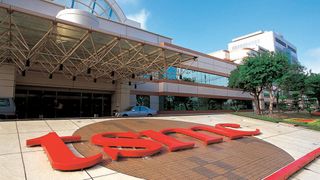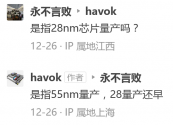(For Russia)According to the article, this demo litho machine exists from 2011 and was planned to become eligible for industrial usage in 2013-2015. Considering that it is still in the demo stage, then probably the transition from the demo to production is very hard.
You are using an out of date browser. It may not display this or other websites correctly.
You should upgrade or use an alternative browser.
You should upgrade or use an alternative browser.
Chinese semiconductor industry
- Thread starter Hendrik_2000
- Start date
- Status
- Not open for further replies.
antiterror13
Brigadier
Surely is not more complicated than Space station or Beidou and many others. The only reason nobody else (apart from ASML) managed to put together EUV is because the market is so specific and not enough market for many players, but now is a different game. Surely Japan, China and the US would be able to make EUV technically, just not economical. Remember that ASML is just integrator, and very little the actual technology invented by ASMLHopefully within next 3-4 years China already can come with EUV Lithography. Designing EUV Lithography is one very difficult thing; but getting 100,000 highly precision parts is another very huge challenge that China need to conquer.
antiterror13
Brigadier
how many 2050i SMIC have? I thought 2050i was banned?Bro what are you looking for? Since SMIC had received a NXT 2050i maybe a possibility of N+3 is on the horizon?
We know TSMC will have a challenging 2023, BUT not this bad and still they plan to invest more believing that doing so in a downturn, they will recoup their investment massively as it takes 2 to 3 years for those new FABS to come on stream as they try to scale up their production of advance node to outcompete its rival. The problem is the market w/o China who they will sell too, I think from 2023 onward we may see the intensification of the tech war and this time China will fight back as the foundation already laid are bearing fruits, slowly BUT surely Chinese self sufficiency are gathering steam and I predict that in 2025 China will be a peer competitor with the US unless TSMC is stupid enough to let the Arizona FAB produced their 3nm chips.
published about 22 hours ago
Large customers revise orders to TSMC due to the economy slowdown.

(Image credit: TSMC)
Being the world's No. 1 foundry, TSMC to the softening high-tech market in Q2 and Q3, but it looks like the party is over even for the world's largest contract chip manufacturer. TSMC's leading customers began to revise their orders to the company, affecting the foundry's results starting from the fourth quarter of 2022, reports .
According to the report, virtually all TSMC clients will experience a downturn and have to cut orders, so TSMC's utilization will decline significantly in Q1 2023. For example, the utilization rate of TSMC's N7-capable lines (7nm, 6nm-class technologies) will decline to around 50% in early 2023. Furthermore, even TSMC's N5/N4-capable lines will be underutilized, though this may not come as a surprise since these are used to make leading-edge products, like Apple's smartphone SoCs, and demand for advanced handsets is usually down in the first half of the year. More alarming is that even N28-capable fabs — which have been fully loaded since the beginning of the chip deficit in early 2021 — will be underutilized.
Due to the slowing economy in China as well as its COVID lockdowns, an economic downturn in numerous European countries, and reduced demand for many products in the U.S., large computer hardware, PCs, and smartphone makers lowered their procurement of new chips from companies like AMD, Intel, MediaTek, and Nvidia. As a result, the fabless chip designers reportedly had no choice but to slash orders to TSMC.
The order cuts will come into effect in Q4 2022, which will increase TSMC's inventories, though it is unclear how the significantly reduced orders will affect the company's revenue this quarter. Meanwhile, DigiTimes estimates that TSMC's Q1 2023 sales will decrease by 15% quarter-over-quarter. By contrast, TSMC's Q1 2022 revenue exceeded its Q4 2021 revenue by 12.1%.
Slashing orders to a contract manufacturer is not trivial since fabless chip designers are obliged to procure a fixed number of wafers in certain quarters. Nevertheless, TSMC is reportedly willing to accept compensation (as it will hold wafers with chips from AMD, Intel, Nvidia, etc., before they are ready to buy them) and even renegotiate deals on long-term supply contracts (i.e., increase the number of wafers that a company is committed to buying in the future) in exchange. Such measures will not make TSMC's life any easier in Q4 2022 or Q2 2023, though.
Market observers generally remain optimistic about the demand for advanced chips returning to normal in 2023. As a result, TSMC is still expected to post revenue growth for the year, but the sales increase may not be as impressive as the 2021 – 2022 period.
AMD, Intel, and Nvidia Reportedly Slash Orders with TSMC
Bypublished about 22 hours ago
Large customers revise orders to TSMC due to the economy slowdown.

(Image credit: TSMC)
Being the world's No. 1 foundry, TSMC to the softening high-tech market in Q2 and Q3, but it looks like the party is over even for the world's largest contract chip manufacturer. TSMC's leading customers began to revise their orders to the company, affecting the foundry's results starting from the fourth quarter of 2022, reports .
According to the report, virtually all TSMC clients will experience a downturn and have to cut orders, so TSMC's utilization will decline significantly in Q1 2023. For example, the utilization rate of TSMC's N7-capable lines (7nm, 6nm-class technologies) will decline to around 50% in early 2023. Furthermore, even TSMC's N5/N4-capable lines will be underutilized, though this may not come as a surprise since these are used to make leading-edge products, like Apple's smartphone SoCs, and demand for advanced handsets is usually down in the first half of the year. More alarming is that even N28-capable fabs — which have been fully loaded since the beginning of the chip deficit in early 2021 — will be underutilized.
Due to the slowing economy in China as well as its COVID lockdowns, an economic downturn in numerous European countries, and reduced demand for many products in the U.S., large computer hardware, PCs, and smartphone makers lowered their procurement of new chips from companies like AMD, Intel, MediaTek, and Nvidia. As a result, the fabless chip designers reportedly had no choice but to slash orders to TSMC.
The order cuts will come into effect in Q4 2022, which will increase TSMC's inventories, though it is unclear how the significantly reduced orders will affect the company's revenue this quarter. Meanwhile, DigiTimes estimates that TSMC's Q1 2023 sales will decrease by 15% quarter-over-quarter. By contrast, TSMC's Q1 2022 revenue exceeded its Q4 2021 revenue by 12.1%.
Slashing orders to a contract manufacturer is not trivial since fabless chip designers are obliged to procure a fixed number of wafers in certain quarters. Nevertheless, TSMC is reportedly willing to accept compensation (as it will hold wafers with chips from AMD, Intel, Nvidia, etc., before they are ready to buy them) and even renegotiate deals on long-term supply contracts (i.e., increase the number of wafers that a company is committed to buying in the future) in exchange. Such measures will not make TSMC's life any easier in Q4 2022 or Q2 2023, though.
Market observers generally remain optimistic about the demand for advanced chips returning to normal in 2023. As a result, TSMC is still expected to post revenue growth for the year, but the sales increase may not be as impressive as the 2021 – 2022 period.
A good summary of recent news.
The article has an error regarding the size of ASML, A €208bn business, it is not. More like there is an extra 8 in that number or they forget a decimal.
ASML annual sales about $20-$25 billion USD
ASML's market cap as of 2022/12/30 is $215.21B USD,so the figure is right
Sir from the Total ASML shipment of 81 to 90 units from 2019 to the 2nd half of 2022, let's say a conservative 12% that will be 10 to 12 units.how many 2050i SMIC have? I thought 2050i was banned?
Oldschool
Junior Member
Registered MemberMay 3, 2022
Hi,
The things to pay attention is the SMIC massive expansion in Shenzhen, Beijing, and Shanghai for 28nm this year.
Last year, news came out that SMIC have received the 11 AMSL DUVs for $1.2B. Each one would cost $100M, that indicates its the most advanced version NXT2050, capable of 7nm, but hvpc indicares that ASML wouldn't deliver so many advanced ones in such short time. So , that leads to so what conflcted views. Maybe it could something for your research.
SMIC-Beijing , i believe had indicated it wants Non-US equipments for its 28nm JV. That means No Applied Material, Lam research, KLA-Tencor. Raimondo , US secretary of commerce indicated US can put SMIC out of business if it aids Russia on chip production. SMIC-Beijing Fab will have Non -US equipments so it would none of US business if it have Russian business.
I don't know about SMIC-Shenzhen, SMIC-shanghai whether they insist on Non-US equipments.
SMIC-Beijing probably has that SMEE 28nm DUV for verification. Naura, CETC , AMEC should supply all other equipments for its 28nm expansion. Nevertheless, ASML DUV should be non of US business anyway
Last edited:
We know TSMC will have a challenging 2023, BUT not this bad and still they plan to invest more believing that doing so in a downturn, they will recoup their investment massively as it takes 2 to 3 years for those new FABS to come on stream as they try to scale up their production of advance node to outcompete its rival. The problem is the market w/o China who they will sell too, I think from 2023 onward we may see the intensification of the tech war and this time China will fight back as the foundation already laid are bearing fruits, slowly BUT surely Chinese self sufficiency are gathering steam and I predict that in 2025 China will be a peer competitor with the US unless TSMC is stupid enough to let the Arizona FAB produced their 3nm chips.
AMD, Intel, and Nvidia Reportedly Slash Orders with TSMC
By
published about 22 hours ago
Large customers revise orders to TSMC due to the economy slowdown.

(Image credit: TSMC)
Being the world's No. 1 foundry, TSMC to the softening high-tech market in Q2 and Q3, but it looks like the party is over even for the world's largest contract chip manufacturer. TSMC's leading customers began to revise their orders to the company, affecting the foundry's results starting from the fourth quarter of 2022, reports .
According to the report, virtually all TSMC clients will experience a downturn and have to cut orders, so TSMC's utilization will decline significantly in Q1 2023. For example, the utilization rate of TSMC's N7-capable lines (7nm, 6nm-class technologies) will decline to around 50% in early 2023. Furthermore, even TSMC's N5/N4-capable lines will be underutilized, though this may not come as a surprise since these are used to make leading-edge products, like Apple's smartphone SoCs, and demand for advanced handsets is usually down in the first half of the year. More alarming is that even N28-capable fabs — which have been fully loaded since the beginning of the chip deficit in early 2021 — will be underutilized.
Due to the slowing economy in China as well as its COVID lockdowns, an economic downturn in numerous European countries, and reduced demand for many products in the U.S., large computer hardware, PCs, and smartphone makers lowered their procurement of new chips from companies like AMD, Intel, MediaTek, and Nvidia. As a result, the fabless chip designers reportedly had no choice but to slash orders to TSMC.
The order cuts will come into effect in Q4 2022, which will increase TSMC's inventories, though it is unclear how the significantly reduced orders will affect the company's revenue this quarter. Meanwhile, DigiTimes estimates that TSMC's Q1 2023 sales will decrease by 15% quarter-over-quarter. By contrast, TSMC's Q1 2022 revenue exceeded its Q4 2021 revenue by 12.1%.
Slashing orders to a contract manufacturer is not trivial since fabless chip designers are obliged to procure a fixed number of wafers in certain quarters. Nevertheless, TSMC is reportedly willing to accept compensation (as it will hold wafers with chips from AMD, Intel, Nvidia, etc., before they are ready to buy them) and even renegotiate deals on long-term supply contracts (i.e., increase the number of wafers that a company is committed to buying in the future) in exchange. Such measures will not make TSMC's life any easier in Q4 2022 or Q2 2023, though.
Market observers generally remain optimistic about the demand for advanced chips returning to normal in 2023. As a result, TSMC is still expected to post revenue growth for the year, but the sales increase may not be as impressive as the 2021 – 2022 period.
With much higher costs in TSMC US fabs, a lot more competition from Chinese fabs, and worldwide recession over the next couple of years, TSMC will have a challenge recouping their investments. This may lead to their bankruptcy. At that time, it may be sold to US investors. But China should step in by voiding any takeover by US entities.
Warren Buffett has made a blunder by investing in TSMC shares.
That is a massive, massive disrespect towards system engineering and is not factual at all. ASML has ~15900 active patents.Remember that ASML is just integrator, and very little the actual technology invented by ASML
- Status
- Not open for further replies.







